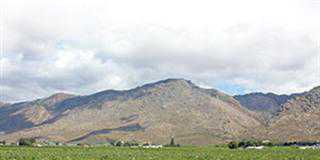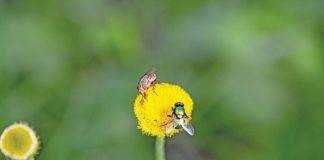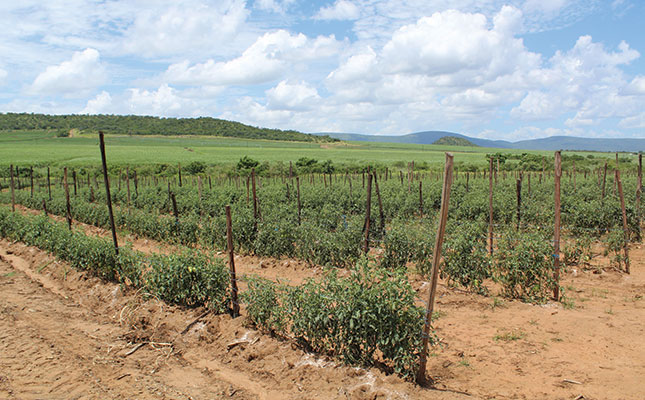
Photo: Lindi Botha
The Pongola of today is far different to what it was in the 1980s. Back then, vegetable farms stretched to the horizon, supplying a wide variety of produce to the area’s markets. Gradually, however, producers began to replace their vegetable crops with sugar cane, as they found the latter far easier to manage.
Today, while sugar cane remains the predominant crop in Pongola, it in turn is under threat of replacement by macadamias.
Brothers Sakkie and André Terblanche have combined the old with the new: their farm, on the outskirts of town, has tomato and sugar cane fields, as well as recently planted macadamia orchards. For them, staying the course with vegetables made business sense, as Basaki Boerdery (Basaki) is one of only three tomato producers in the area, which ensures that they have a stable market.
Lately, however, they haven’t been able to keep up with demand, as tomato leaf miner (Tuta absoluta) is threatening to destroy their livelihood.
“We started noticing leaf miner in our tomato crops around 2014,” says Sakkie. “Up until then, we had to contend with the normal pests and diseases known to affect tomatoes, such as blight and red spider mite, but they were manageable.
“But with Tuta, we found that we couldn’t stay ahead. It takes you out quickly, so you need to act fast.
“We had to completely change our production cycles and management practices […].”
Prior to 2014, Basaki planted seven plots of 7ha each to tomatoes, and these were replanted every 34 weeks. This allowed for a continuous harvest over the 34-week period, yielding between 80t/ha and 100t/ha.
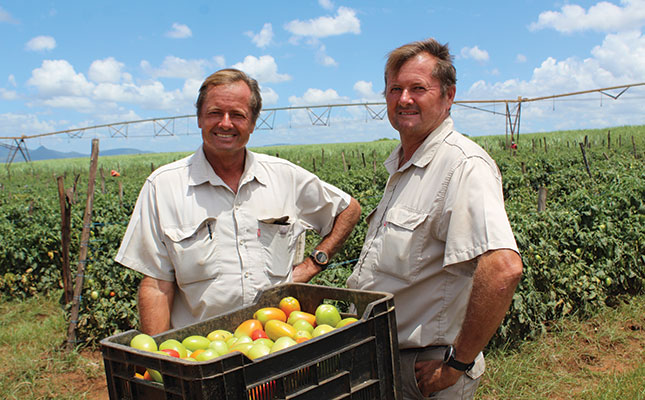
Since the advent of the tomato leaf miner in the area, the Terblanches have reduced the size of the plots to 3,5ha each, and these are now in production for only four weeks. Once the cycle has been completed, the land is returned to sugar cane for at least five years before tomatoes are planted again. This strategy, however, has cut their tomato yield in half, to around 50t/ha.
Sakkie explains that they can harvest only one cycle of tomatoes before the crop is completely destroyed by the pest.
“Tuta affects the plants the minute you plant out the seedlings, and the bigger the plants get, the more expensive it is to control the moths. You therefore need to harvest as soon as you get to four weeks, removing all the tomatoes and then the plants themselves.”
Basaki produces tomatoes throughout the year and has around 24ha planted to the crop at any one time. Due to their shorter tomato production cycle, they focus on varieties that grow faster.
The tomato leaf miner has also influenced their market. Whereas they used to deliver to a supermarket group, the Terblanches found that, in addition to the toll gate and transport fees, the reduced packout rate as a result of the pest meant it no longer made sense to supply this group.
“This client wanted only top-grade tomatoes that didn’t have marks on them. Because the moth leaves marks on the outside of tomatoes when it stings them, this produce had to be excluded, even though the quality inside was still good.
“So we had to sell our top-grade tomatoes at the average market price, well below their true value. We then still had to sell the rest of the tomatoes that didn’t make that grade. In the end, we found it far better to supply the local market, straight from our packhouse. We also saved on transport and packaging fees,” says Sakkie.
As the number of vegetable farmers in Pongola has dwindled, Basaki capitalises on the lack of fresh produce in the area. They supply the surrounding towns and their supermarkets, in addition to the many informal traders who collect produce directly from the farm. They also deliver daily consignments to informal traders.
An alternative production season
Although demand for tomatoes is high, the Terblanches understand that consumers are price-sensitive, which means that hiking prices will not guarantee their sustainability. This presents a major problem, as the costs of the chemicals used to keep T. absoluta under control are mounting.
The infestation starts with larvae that burrow into the leaves of the tomato plant and then move into the stems, eventually killing off the entire plant, often before the tomatoes have had a chance to ripen.
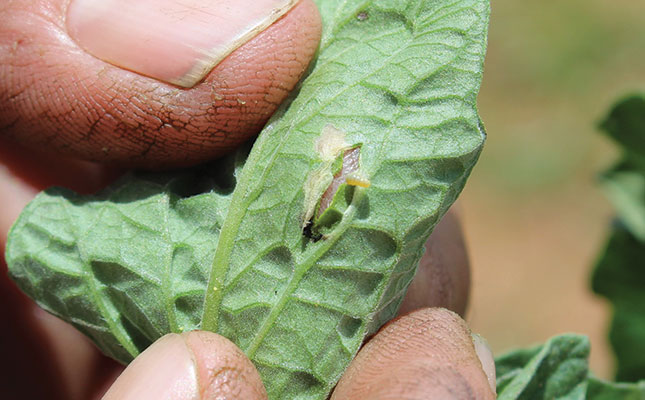
Pongola’s balmy climate is an ideal breeding ground for the pest: its life cycle speeds up under these conditions, resulting in a far higher level of infestation than would be the case in cooler areas.
In a region where summer temperatures reach 40°C during the day and cool down to only 28°C at night, it’s surprising that Basaki grows tomatoes during this season. But, even though the pest load is extreme, the higher market prices make production worthwhile, as there is an overall shortage of tomatoes at this time of year.
“In winter, when supply is high, we struggle to break even. The farmers on the Makatini Flats further south grow tomatoes in winter, but because they’re subsidised by government, their produce reaches the market at far lower prices than ours does. This makes it very difficult for us to stay afloat,” laments Sakkie.
Ongoing management
The nature of T. absoluta keeps the Terblanche brothers busy every day. To give the crop added protection against pests and diseases, they begin by treating the seedlings before they leave the nursery. They then carefully monitor the growing plants for any signs of infestation.
T. absoluta is quick to adapt to chemical control measures, and has already developed resistance to a number of active ingredients. Thus, a control measure that works today might not work next week.
“You can’t plant tomatoes and think they’re just going to grow and be okay on their own,” says Sakkie. “We need to be in the lands ourselves, twice a day, walking between the rows so we can make quick decisions if more action needs to be taken against the pest.
“It’s important to note what stage of the life cycle it’s in, so you can apply the correct chemical. The wrong chemical will be ineffective in preventing the pest’s next stage of development, and the infestation load will go through the roof.”
André notes that other pests on the farm are now negligible, as the damage they inflict is next to nothing compared with what the tomato leaf miner can do.
“Many other pests only attack the plant if it’s weak, but the health of the plant makes no difference to Tuta. We therefore stick to calendar spray applications, and top up with additional spraying when there are severe outbreaks,” he explains.
Pheromone traps are used in the lands to lure the males, but no other biological pest control method has been found to work. André ascribes this to the area’s high temperatures, which render these products unsuccessful.
There are six active ingredients that can be used to combat the pest, and the Terblanches alternate them so that the moths don’t build up resistance. Care is also taken to apply the pesticide correctly, adding buffers and wetters to achieve maximum protection from the chemicals. It’s also prudent not to spray at the hottest time of the day, or the chemicals will lose their efficacy.
Sakkie admits, however, that while none of their control measures actually destroy the pest, their impact is at least reduced to a point where the crop can be harvested.
“Some tomatoes will still have sting marks, but if they’re picked in time, the quality won’t be affected. But because of the blemishes, the produce needs to go through as second grade, which affects the price,” he says.
Staying in the game, for now
The cost of chemical control and reduced yields is becoming prohibitive, and the Terblanches are reaching a stage where farming tomatoes will no longer be economically feasible.
“We have a number and once we reach it, the tomatoes will be removed. It’ll be difficult, because we’ve been farming tomatoes for so long. We are Basaki; tomatoes are what we do,” says Sakkie.
The outlook for tomato prices is also not encouraging, as this staple is sensitive to supply and demand curves. For now, the Terblanches rely on the premium they get in the summer months when they are the only suppliers in the area.
As far as a solution to the pest goes, they aren’t hopeful. “There is a growing awareness about the pest, and it seems as though the department of agriculture is starting to conduct research on it, but so far it has come to nothing,” says Sakkie.
“So many farmers have exited the industry because of T. absoluta, yet it seems as though nothing is being done. Tomatoes are a staple food; they can’t go out of production. People in the community have already expressed concern that we might stop farming tomatoes, as there won’t be any in this area for a large part of the year.”
In the meantime, the Terblanches are spreading their risk. When rumours began circulating that the area’s sugar mill would be cutting quotas for farmers, rather than replant some of their cane fields to tomatoes, the brothers opted for macadamias instead.
“The risk with tomatoes is just getting too high, and the future of sugar is also questionable. But for now, we don’t plan on eliminating either one completely. We just hope we’ll be able to continue fighting off T. absoluta and keep supplying our market,” says Sakkie.
Email Sakkie or André Terblanche at [email protected].











